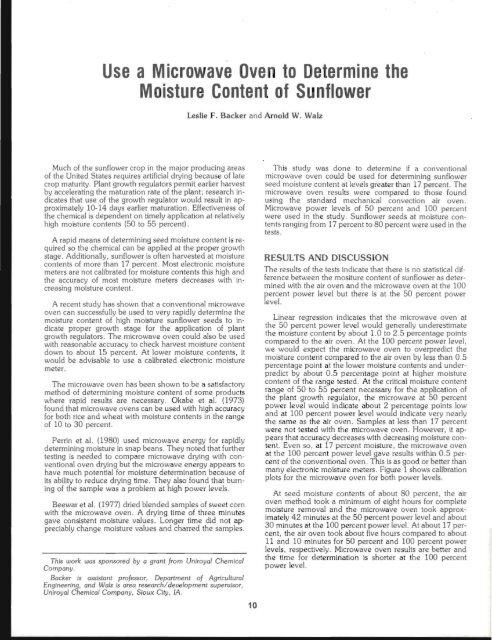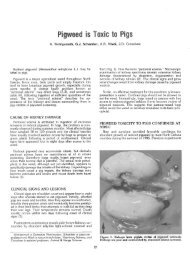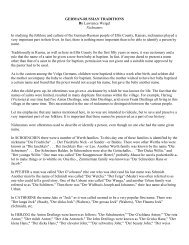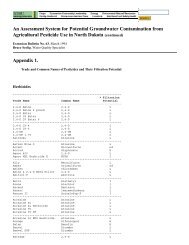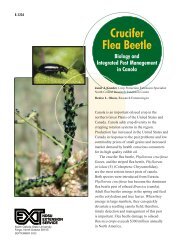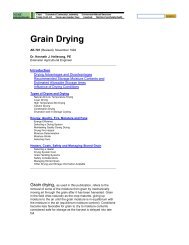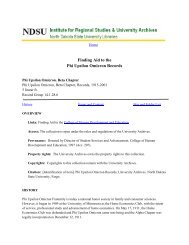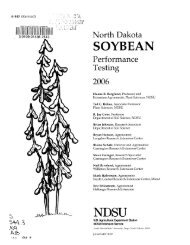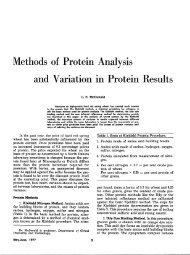Use a Microwave Ove to Determine the Moisture Content of S nflower
Use a Microwave Ove to Determine the Moisture Content of S nflower
Use a Microwave Ove to Determine the Moisture Content of S nflower
Create successful ePaper yourself
Turn your PDF publications into a flip-book with our unique Google optimized e-Paper software.
<strong>Use</strong> a <strong>Microwave</strong> <strong>Ove</strong> <strong>to</strong> <strong>Determine</strong> <strong>the</strong> <br />
<strong>Moisture</strong> <strong>Content</strong> <strong>of</strong> S <strong>nflower</strong> <br />
Leslie F. Backer and Arnold W. Walz<br />
Much <strong>of</strong> <strong>the</strong> su<strong>nflower</strong> crop in <strong>the</strong> major producing areas<br />
<strong>of</strong> <strong>the</strong> United States requires artificial drying because <strong>of</strong> late<br />
crop maturity. Plant growth regula<strong>to</strong>rs permit earlier harvest<br />
by accelerating <strong>the</strong> maturation rate <strong>of</strong> <strong>the</strong> plant; research in <br />
dicates that use <strong>of</strong> <strong>the</strong> growth regula<strong>to</strong>r would result in approximately<br />
10-14 days earlier maturation. Effectiveness <strong>of</strong><br />
<strong>the</strong> chemical is dependent on timely application at relatively<br />
high moisture contents (50 <strong>to</strong> 55 percent).<br />
A rapid means <strong>of</strong> determining seed moisture content is required<br />
so <strong>the</strong> chemical can be applied at <strong>the</strong> proper growth<br />
stage . Additionally, su<strong>nflower</strong> is <strong>of</strong>ten harvested at moisture<br />
contents <strong>of</strong> more than 17 percent. Most electronic moisture<br />
meters are not calibrated for moisture contents this high and<br />
<strong>the</strong> accuracy <strong>of</strong> most moisture meters decreases with in <br />
creasing moisture content.<br />
A recent study has shown that a conventional microwave<br />
oven can successfully be used <strong>to</strong> very rapidly determine <strong>the</strong><br />
moisture content <strong>of</strong> high moisture su<strong>nflower</strong> seeds <strong>to</strong> indicate<br />
proper growth stage for <strong>the</strong> application <strong>of</strong> plant<br />
growth regula<strong>to</strong>rs. The microwave oven could also be used<br />
with reasonable accuracy <strong>to</strong> check harvest moisture content<br />
down <strong>to</strong> about 15 percent. At lower moisture contents, it<br />
would be advisable <strong>to</strong> use a calibrated electronic moisture<br />
meter.<br />
The microwave oven has been shown <strong>to</strong> be a satisfac<strong>to</strong>ry<br />
method <strong>of</strong> determining moisture content <strong>of</strong> some products<br />
where rapid results are necessary. Okabe et al. (1 973)<br />
found that microwave ovens can be used with high accuracy<br />
for both rice and wheat with moisture contents in <strong>the</strong> range<br />
<strong>of</strong> 10 <strong>to</strong> 30 percent.<br />
Perrin et al. (1980) used microwave energy for rapidly<br />
determining moisture in snap beans. They noted that fur<strong>the</strong>r<br />
testing is needed <strong>to</strong> compare microwave drying with conventional<br />
oven drying but <strong>the</strong> microwave energy appears <strong>to</strong><br />
have much potential for moisture determination because <strong>of</strong><br />
its ability <strong>to</strong> reduce drying time. They also found that burning<br />
<strong>of</strong> <strong>the</strong> sample was a problem at high power levels.<br />
Beewar et al. (1977) dried blended samples <strong>of</strong> sweet corn<br />
with <strong>the</strong> microwave oven. A drying time <strong>of</strong> three minutes<br />
gave consistent moisture values. Longer time did not appreciably<br />
change moisture values and charred <strong>the</strong> samples.<br />
This UJork was sponsored by a grant from Uniroyal Chemical<br />
Company.<br />
Backer is assistant pr<strong>of</strong>essor, Department <strong>of</strong> Agricultural<br />
Engineering, and Wa/z is area research/development supervisor,<br />
Uniroyal Chemical Company, Sioux City, lA.<br />
10<br />
This study was done <strong>to</strong> determine if a conventional<br />
microwave oven could be used for determining su<strong>nflower</strong><br />
seed moisture content at levels greater than 17 percent. The<br />
microwave oven results were compared <strong>to</strong> those found<br />
using <strong>the</strong> standard mechanical convection air oven.<br />
<strong>Microwave</strong> power levels <strong>of</strong> 50 percent and 100 percent<br />
were used in <strong>the</strong> study. Su<strong>nflower</strong> seeds at moisture contents<br />
ranging from 17 percent <strong>to</strong> 80 percent were used in <strong>the</strong><br />
tests.<br />
RESULTS AND DISCUSSION<br />
The results <strong>of</strong> <strong>the</strong> tests indicate that <strong>the</strong>re is no statistical difference<br />
between <strong>the</strong> mositure content <strong>of</strong> su<strong>nflower</strong> as determined<br />
with <strong>the</strong> air oven and <strong>the</strong> microwave oven at <strong>the</strong> 100<br />
percent power level but <strong>the</strong>re is at <strong>the</strong> 50 percent power<br />
level.<br />
linear regression indicates that <strong>the</strong> microwave oven at<br />
<strong>the</strong> 50 percent power level would generally underestimate<br />
<strong>the</strong> moisture content by about 1.0 <strong>to</strong> 2.5 percentage points<br />
compared <strong>to</strong> <strong>the</strong> air oven. At <strong>the</strong> 100 percent power level,<br />
we would expect <strong>the</strong> microwave oven <strong>to</strong> overpredict <strong>the</strong><br />
moisture content compared <strong>to</strong> <strong>the</strong> air oven by less than 0.5<br />
percentage point at <strong>the</strong> lower moisture conte nts and underpredict<br />
by about 0 .5 percentage point at higher moisture<br />
content <strong>of</strong> <strong>the</strong> range tested . At <strong>the</strong> critical moisture content<br />
range <strong>of</strong> 50 <strong>to</strong> 55 percent necessary for <strong>the</strong> application <strong>of</strong><br />
<strong>the</strong> plant growth regula<strong>to</strong>r, <strong>the</strong> microwave at 50 percent<br />
power level would indicate about 2 percentage points low<br />
and at 100 percent power level would indicate very nearly<br />
<strong>the</strong> same as <strong>the</strong> air oven. Samples at less than 17 percent<br />
were not tested with <strong>the</strong> microwave oven. However, it appears<br />
that accuracy decreases with decreasing moisture content.<br />
Even so, at 17 percent moisture <strong>the</strong> microwave oven<br />
at <strong>the</strong> 100 percent power level gave results within 0.5 percent<br />
<strong>of</strong> <strong>the</strong> conventional oven. This is as good or better than<br />
many electronic moisture meters. Figure 1 shows calibration<br />
plots for <strong>the</strong> microwave oven fo r both power levels.<br />
At seed moisture contents <strong>of</strong> about 80 percent, <strong>the</strong> air<br />
oven method <strong>to</strong>ok a minimum <strong>of</strong> eight hours for complete<br />
moisture removal and <strong>the</strong> microwave oven <strong>to</strong>ok approximately<br />
42 minutes at <strong>the</strong> 50 percent power level and about<br />
30 minutes at <strong>the</strong> 100 percent power level. At about 17 percent,<br />
<strong>the</strong> air oven <strong>to</strong>ok about five hours compared <strong>to</strong> about<br />
11 and 10 minutes for 50 percent and 100 percent power<br />
levels, respectively. <strong>Microwave</strong> oven results are better and<br />
<strong>the</strong> time for determination is shorter at <strong>the</strong> 100 percent<br />
power level.
85<br />
.0<br />
::e ~ 75 I<br />
0<br />
~<br />
Z<br />
.- W<br />
z 65<br />
0<br />
0<br />
w<br />
a:<br />
.-<br />
::> 55<br />
en<br />
i5<br />
~<br />
z<br />
w 45<br />
><br />
0<br />
w<br />
> ct<br />
3: 35<br />
0<br />
a:<br />
0 ----.c:.--- 50%<br />
i --0-- - 100%<br />
25<br />
15 25 35 45 55 65 75 85<br />
AI R OVEN MOISTURE CONTENT, %wb<br />
Figure 1. Plot <strong>of</strong> air oven moisture content versus<br />
moisture content determined with <strong>the</strong> microwave oven at<br />
<strong>the</strong> 50% and 100% power levels. Each data point is <strong>the</strong><br />
mean <strong>of</strong> four replications.<br />
3 . Weigh <strong>the</strong> paper <strong>to</strong>wel using a gram scale and record<br />
<strong>the</strong> weight.<br />
4. With <strong>the</strong> <strong>to</strong>wel on <strong>the</strong> scale , pour a sample <strong>of</strong> seeds on<strong>to</strong><br />
<strong>the</strong> scale and record that weight. .<br />
5. Place <strong>the</strong> <strong>to</strong>wel and seeds in<strong>to</strong> <strong>the</strong> microwave oven;<br />
spread <strong>the</strong> seeds on <strong>the</strong> <strong>to</strong>wel <strong>to</strong> a thickness <strong>of</strong> no more<br />
than about two seeds. It is very important <strong>to</strong> spread <strong>the</strong><br />
seeds <strong>to</strong> a thickness <strong>of</strong> nor more than about two seeds.<br />
6. <strong>Microwave</strong> for four-minute intervals; take out <strong>the</strong> sample<br />
and weigh it after each period. When <strong>the</strong> difference<br />
in weighings becomes small start weighing at two-·<br />
minute intervals until <strong>the</strong>re is no weight change. Lack<br />
<strong>of</strong> weight change indicates that <strong>the</strong> moisture has been<br />
removed .<br />
7. If running repeated samples for a long time, check <strong>to</strong><br />
see if <strong>the</strong> glass tray in <strong>the</strong> oven is getting hot. If so, let<br />
<strong>the</strong> tray cool before running ano<strong>the</strong>r test. If a sample<br />
starts <strong>to</strong> smoke or appears charred after a test, discard<br />
this sample and start ano<strong>the</strong>r test after <strong>the</strong> oven and<br />
tray cool.<br />
8. Calculate <strong>the</strong> original seed moisture content <strong>of</strong> <strong>the</strong><br />
sample by using <strong>the</strong> following equation. Be sure <strong>to</strong> subtract<br />
<strong>the</strong> weight <strong>of</strong> <strong>the</strong> paper <strong>to</strong>wel from <strong>the</strong> initial and<br />
final sample wieghts before you begin <strong>the</strong> calculations.<br />
<strong>Moisture</strong> content = (I nitial weight - Final weight) / (Initial<br />
weight) x 100.<br />
9. Be sure <strong>to</strong> run a minimum <strong>of</strong> four tests and average <strong>the</strong><br />
results .<br />
10 . Do not leave <strong>the</strong> microwave oven unattended during<br />
<strong>the</strong> tests.<br />
A PRACTICAL PROCEDURE<br />
The following procedure is suggested for testing <strong>the</strong><br />
moisture content <strong>of</strong> high moisture su<strong>nflower</strong> with <strong>the</strong><br />
microwave oven .<br />
1. Harvest seed samples fro m different parts <strong>of</strong> <strong>the</strong> fie ld<br />
and mix all samples <strong>to</strong>ge<strong>the</strong>r. Separate this <strong>to</strong>tal sampie<br />
in<strong>to</strong> at least four 50 gram samples for <strong>the</strong> tests.<br />
Make sure <strong>the</strong> samples are clean, hand pick out foreig n<br />
material if necessary.<br />
2. First, dry a paper <strong>to</strong>wel. (The amount <strong>of</strong> moisture in<br />
<strong>the</strong> paper <strong>to</strong>wel is very small and will not make much<br />
differe nce if this step is omitted.)<br />
REFERENCES<br />
1. Beewar M. R. , N. Mansour and G.W. Varseveld. 1977.<br />
<strong>Microwave</strong> drying: A rapid method for determining sweet com<br />
moisture . Hort. ScL , 12(6):562-563.<br />
2 . Okabe , T. . M.T. Huang and S. Okamura . 1973. A new<br />
method for <strong>the</strong> measurement <strong>of</strong> grain moisture content by <strong>the</strong><br />
use <strong>of</strong> microwaves. J. Agric. Eng. Res., 18, p . 59-66.<br />
3. Perrin, D. R. , L.R. Wilhelm and C .A . Mullins. 1980. Evaluation<br />
<strong>of</strong> microwave energy for rapidly determining moisture in snap<br />
beans . ASAE Paper No. 80-3527, ASAE, St. Joseph , MI<br />
49085.<br />
11


